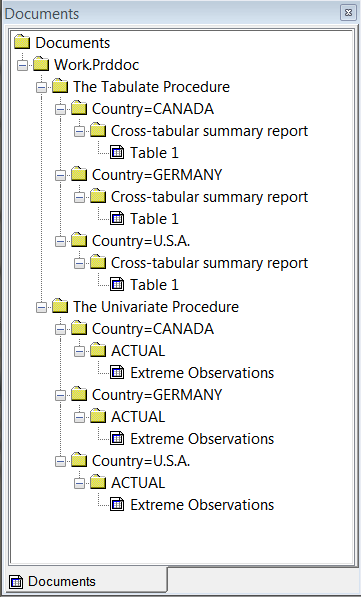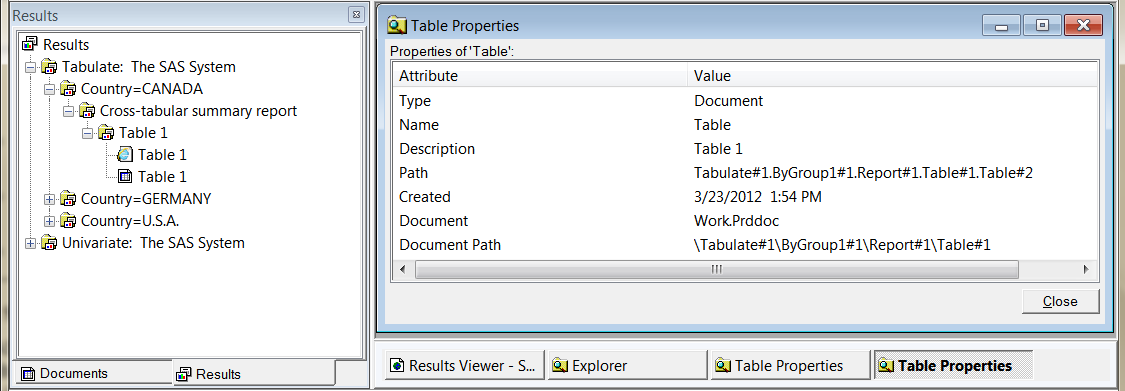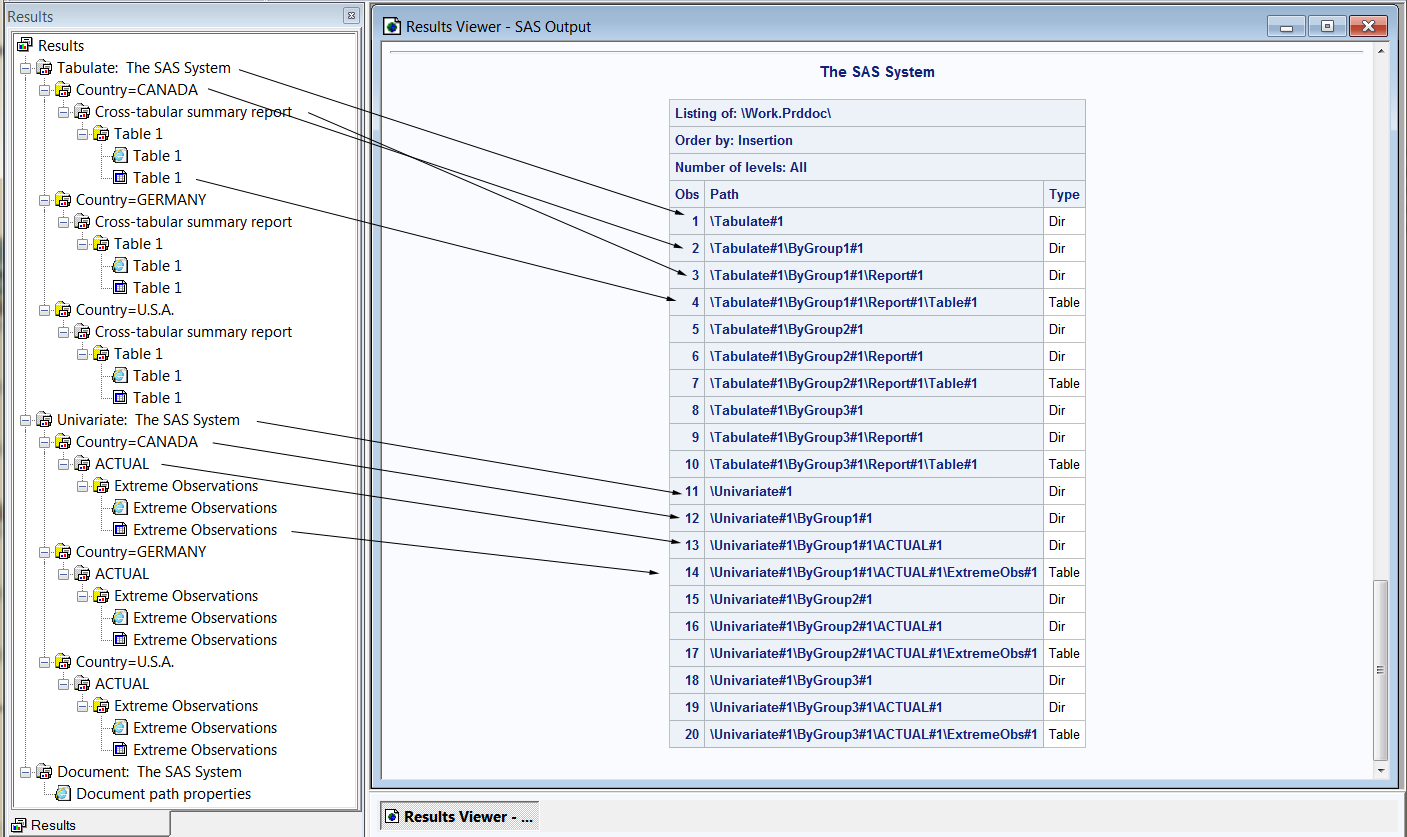The DOCUMENT Procedure
- Syntax
 Procedure SyntaxPROC DOCUMENT StatementCOPY TO StatementDELETE StatementDIR StatementDOC StatementDOC CLOSE StatementHIDE StatementIMPORT TO StatementLINK StatementLIST StatementMAKE StatementMOVE TO StatementNOTE StatementOBANOTE StatementOBBNOTE StatementOBFOOTN StatementOBPAGE StatementOBSTITLE StatementOBTEMPL StatementOBTITLE StatementRENAME TO StatementREPLAY StatementSETLABEL StatementUNHIDE Statement
Procedure SyntaxPROC DOCUMENT StatementCOPY TO StatementDELETE StatementDIR StatementDOC StatementDOC CLOSE StatementHIDE StatementIMPORT TO StatementLINK StatementLIST StatementMAKE StatementMOVE TO StatementNOTE StatementOBANOTE StatementOBBNOTE StatementOBFOOTN StatementOBPAGE StatementOBSTITLE StatementOBTEMPL StatementOBTITLE StatementRENAME TO StatementREPLAY StatementSETLABEL StatementUNHIDE Statement - Overview
- Concepts
- Using

- Results
- Examples

Concepts: DOCUMENT Procedure
About ODS Documents
Overview
An ODS document is a
hierarchical file of output objects that is created from a procedure
or data query. The ODS document holds these output objects in their
original structures, but you can rearrange the hierarchy and structure
of these objects. ODS documents are stored in a proprietary format
(a document store) and can be viewed only
with SAS software. To view or modify what is in the document store,
you must use either the Documents window
or the DOCUMENT procedure.
To create an ODS
document, you must use the ODS DOCUMENT Statement. The following code creates the ODS
document Work.Prddoc within a document store:
ods listing close;
proc sort data=sashelp.prdsale out=prdsale;
by Country;
run;
ods document name=work.prddoc(write);
proc tabulate data=prdsale;
by Country;
var predict;
class prodtype;
table prodtype all,
predict*(min mean max);
run;
ods select ExtremeObs;
proc univariate data=prdsale;
by Country;
var actual;
run;
ods document close; The following display
shows the document Work.Prddoc and its contents. To view the Documents window,
submit this command in the command bar:
odsdocuments SAS Documents Window Showing Document and Documents Icon

The following display
shows the properties of Table 1. You can see the document name and
the document path, among other information.
Table Properties for Table 1

An ODS document store
is not a SAS data set, as you can see by the document icon in the
preceding display. This ODS document was written to the Work library.
However, if it had been written to a permanent location (such as c:\temp\output),
you would see in Windows Explorer that the document store has a file
extension of SAS7BITM.
ODS Document Persistence
An ODS
document persists in the SAS system until the document, or the SAS
library containing the document, is deleted. An ODS document that
was created in the Sasuser library, or in another permanent SAS library,
can persist indefinitely. It is considered a permanent archive of
SAS procedure output. However, an ODS document that is created in
the Work library does not persist longer than the SAS session that
created it. For information about SAS libraries, see SAS Language Reference: Concepts.
Viewing the Contents of an ODS Document
After you have created
a document with the ODS DOCUMENT statement, you can use PROC DOCUMENT
to view the contents of your document. You can rearrange, duplicate,
or remove output from the results of a procedure or a database query
without invoking the procedures from the original report. The first
step is to view your document’s contents by using the LIST
statement. The LIST statement enables you to look at the object list
and folder structure within the ODS document. The following code creates
a list of all levels of the document Work.Prddoc:
proc document name=work.prddoc;
list / levels=all;
run;
quit;The LIST statement can be used to list what is
in an entire document or just one of the entries. For more information
about the LIST statement, see LIST Statement.In the following display,
every folder icon in the Results window corresponds
to an item with a type of "Dir" in the LIST statement output. Every
table created by a procedure corresponds to an item with a type of
"Table" in the LIST statement output.
PROC DOCUMENT List Output Compared to Results Window

Understanding an ODS Document Path
Definition of ODS Document Path
An ODS document is stored
as an item store. This file format enables client applications to
define a hierarchical file system within a file. This is similar to
a directory system in a UNIX or Windows operating environment. Therefore,
an ODS document path indicates the location of an entry. In the preceding
output, the document path for the entry Country=Canada is \Tabulate#1.
Understanding Sequence Numbers
Entry names are not
required to be unique within an ODS document. However, they are uniquely
identifiable because they contain sequence numbers. Every entry in
an ODS document, except for the root directory, has a sequence number.
A sequence number is a positive integer that is unique with respect
to the name of the entry within the same directory. Entries are assigned
sequence numbers according to the sequence in which they are added
to a directory. For example, the first entry
myname is
assigned a sequence number 1, myname#1.
The second entry myname is assigned
a sequence number 2, myname#2. Sequence
numbers are never reassigned, unless all entries with the same name
are deleted. In this case, the sequence numbers are reset to have
an initial number of 1.
ODS Documents and Base SAS Procedures
You can create an ODS
document from almost any Base SAS procedure. The PRINT, REPORT, and
TABULATE procedures use table templates that are created by the user
and not defined by an external template in ODS. These procedures use
custom table templates, custom data components, and custom formats
for their output objects. Nevertheless, the ODS document and all of
its features are supported for the PRINT, TABULATE, and REPORT procedures.
Getting Familiar with Output Objects
An output object is
one of the following:
Output objects have associated information and attributes.
Some or all of the following attributes pertain to output objects:
is the note assigned
to the output object by the procedure that produced the object. This
note is displayed every time the output object is displayed. After-notes
display after the output object.
is the note assigned
to the output object by the procedure that produced the object. This
note is displayed every time the output object is displayed. Before-notes
display before the output object.